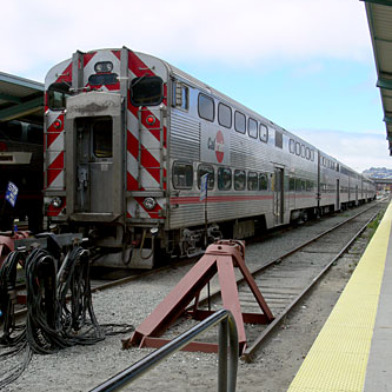 Modernizing the Caltrain corridor with electrified trains and updated signal systems could create 9,600 jobs in the Bay Area, according to a report released this week by the Bay Area Council Economic Institute.
Modernizing the Caltrain corridor with electrified trains and updated signal systems could create 9,600 jobs in the Bay Area, according to a report released this week by the Bay Area Council Economic Institute.
The 40-page report, called “The Economic Impact of Caltrain Modernization,” was discussed this morning by transit advocates and elected officials at Caltrain’s Sequoia Station in Redwood City.
Rep. Anna Eshoo, D-Palo Alto, who last year called for the California High Speed Rail Authority to work toward developing a blended rail system on the Peninsula that would accommodate both Caltrain vehicles and high speed trains, called on state legislators to include Caltrain modernization funding in the state budget.
“A modernized Caltrain is good for the Peninsula, good for the Bay Area, and good for California,” Eshoo said. “Modernizing the system is a win on every level.”
Jim Wunderman, the Bay Area Council’s president and CEO, said that the rail modernization project, which if started in the next year could bring an electric train system between San Jose and San Francisco by 2019, would decrease carbon emissions, reduce congestion on nearby U.S. Highway 101, and carry up to 30,000 additional passengers per day.
“Ridership is going up and up and up, and we have to do something to meet the demand,” Wunderman said.
Besides providing around 9,600 jobs in construction, delivery and production, the Caltrain Modernization Program could generate billions of dollars in benefits, including short-term economic stimulus and long-term increases in real estate values, and improvements in the region’s productivity by speeding up traffic mobility and decreasing the number of hours lost on congested roadways.
In May, the Metropolitan Transportation Commission approved a memorandum of understanding with the California High-Speed Rail Authority to provide $1.5 billion toward modernizing Caltrain and preparing the corridor for a blended rail system.
San Mateo County Supervisor and MTC Chair Adrienne Tissier said that nine different Bay Area transit agencies and local governments approved the memorandum of understanding, which was ultimately approved by the CHRSA.
“The whole Bay Area is behind it,” Tissier said.
“It’s good jobs policy, its good economic development policy, and good environmental policy,” she said.
Tissier and Eshoo called on the public to continue to support Caltrain modernization by contacting state representatives, whose state budget negotiations will determine how much money is designated for high-speed rail and its associated projects.
The Bay Area Council report can be downloaded online at http://documents.bayareacouncil.org/caltrainecon.pdf.
Chris Cooney, Bay City News
Want more news, sent to your inbox every day? Then how about subscribing to our email newsletter? Here’s why we think you should. Come on, give it a try.









